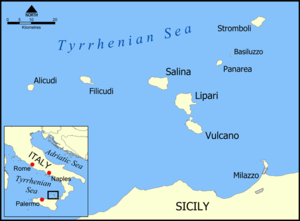Aeolian Islands
The Aeolian Islands (Italian Isole Eolie) are a volcanic archipelago in the Tyrrhenian Sea north of Sicily. They are a popular tourist destination in the summer, and attract up to 200,000 visitors annually.
The largest island is Lipari, and tourism marketing often names the entire archipelago the Lipari Islands because of the ease of pronouncing Lipari compared to Aeolian. The other islands include Vulcano, Salina, Stromboli, Filicudi, Alicudi, and Panarea. The town of Lipari has about 11,000 inhabitants. Vulcano is famous for its fango baths.
History
The Cnidian settlers under Pentathlos arrived at Lipara in 580 BC and settled on the site of the modern village known as Castello or la Cittade. They named the islands after the Greek keeper of the winds, Aeolus, whose benevolence was essential. Outside Lipara, on the road to the necropolis, a sanctuary to Demeter and Persephone has been discovered. The islands were the site of the Battle of the Lipari Islands in 260 BC between Rome and Carthage. Biblical historian Josephus mentioned a group that is probably related to the Aeolian islands: "Elisa gave name to the Eliseans, who were his subjects; they are now the Aeolians." Elisa refers to the biblical figure Elishah, grandson of Japheth, son of Javan.
In 1544, when Spain declared war on France, the French king Francois I, asked the Ottoman Sultan Suleiman for help. The latter sent a fleet headed by Khair ad Din (also known as Barbarossa) who was victorious over the Spaniards, and managed to retake Naples from them. In the course of the battle the Aeolian Islands were depopulated. Later immigrants from mainland Italy, Sicily and Spain re-established communities on the archipelago.
The Aeolian Islands have been listed by the UNESCO as World Heritage Sites.
External links
- UNESCO World Heritage Sites, Aeolian Islands
- Aeolian Islands tourism website (in Italian).
- Richard Stillwell, ed. Princeton Encyclopedia of Classical Sites, 1976: "Aeoliae Insulae (Lipari Islands), Messina, Sicily"
| L'Aquila (Abruzzo) · Aosta (Aosta Valley) · Bari(Apulia) · Potenza (Basilicata) · Catanzaro (Calabria) · Naples (Campania) · Bologna (Emilia-Romagna) Trieste (Friuli-Venezia Giulia) · Rome (Lazio) · Genoa (Liguria) · Milan (Lombardy) · Ancona (Marche) · Campobasso (Molise) · Turin (Piedmont) |
| Regions of Italy | ||||
|---|---|---|---|---|
| Abruzzo • Aosta Valley • Apulia • Basilicata • Calabria • Campania • Emilia-Romagna • Friuli-Venezia Giulia • Lazio • Liguria • Lombardy • Marche • Molise • Piedmont • Sardinia • Sicily • Trentino-South Tyrol • Tuscany • Umbria • Veneto | ||||
